Upstream Worm Lines
The Importance of Line Sag
When the upstream worm technique was in common use, anglers fished with a horsehair line. Horsehair is not very strong, so to make a line with sufficient strength, multiple hairs were twisted together. The resulting line was heavier than most modern fly lines and much heavier than modern tenkara lines.
However, that was not entirely a bad thing. The heavy line produced significant line sag. I have come to believe that line sag is a critical element in tenkara fishing and and is the critical element in upstream worm fishing.
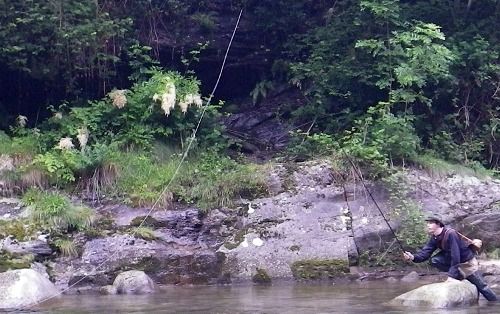 Sag of a horsehair line
Sag of a horsehair lineWhen I first tried Ultralight Worm Fishing (which I should have called The Upstream Worm, but at that time I didn't realize it was a recognized technique that had a name), I was sure a tenkara line
would allow me to make the cast. After all, it casts nearly weightless flies without any
added weight.
It turns out using a tenkara line provides three tremendous benefits relative to the light lines used in either keiryu fishing or spin fishing:
- It has enough weight to make the cast without split shot. Not using
split shot nearly eliminates getting snagged in the rocks on the bottom,
which can be a significant problem when keiryu fishing in shallow
streams. With no added weight on the line, the worm goes with the
water's flow over and around rocks. It also achieves a much more natural drift.
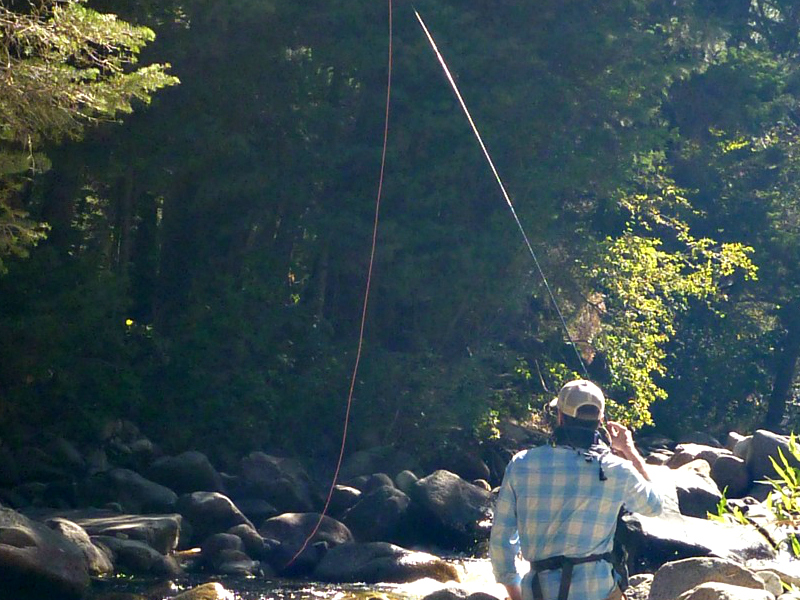 Sag of a light tenkara line.
Sag of a light tenkara line.Notice the curve in the last few feet of line.
- The curve caused by the sagging line is an extremely sensitive strike indicator. As the worm drifts down towards you with the current, lift your rod tip enough to keep the end of the hi-vis tenkara line off the surface, but not so much that it pulls the worm faster than the current.
- Keeping the worm drifting at the speed of the current will keep a bit of
sag in the line. When a fish takes the worm, the line will stop. If you
are smoothly moving the rod tip at the speed of the current, the line
will straighten.
Since the worm usually goes over and around rocks rather than getting
caught on them, if the line straightens it is almost certainly a fish.
The line might not just straighten, it might move to the side or shoot
upstream by as much as a foot. If a fish takes the worm, you'll see it.
If your worm is in an eddy or a very slow pool, the indication of a
strike might be extremely subtle, perhaps just a slight twitch or
wiggling of the line. In general, the slower the current, the more
subtle the strike. Concentrate on the curvature of the line near the water's surface.
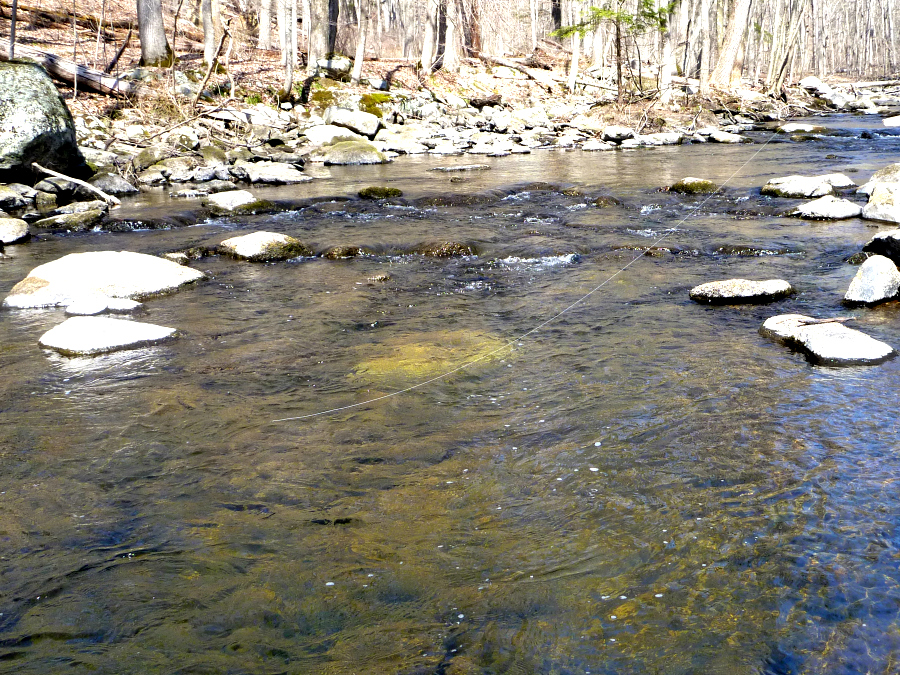 Curve caused by line sag provides a bit of slack.
Curve caused by line sag provides a bit of slack.- The line sag provides a bit of slack so the fish can take the worm and not feel immediate tension on the line. A trout will spit out a worm if it feels tension on the line! I am convinced that feeling tension is a more immediate trigger that something is wrong than feeling the hook (although I would still use small hooks - which will be covered in a later section). When a fish takes the worm, you will see the line straighten or move before the fish feels tension. You'll know it's there before it knows you're there.
For upstream worm lines I have used size 2.5 and size 3 hi-vis fluorocarbon and a Fujino tapered nylon line. Some of the tenkara rods that would be appropriate for fishing the upstream worm would do better with a size 3.5 line.
Although I have not yet tried size 3.5 or size 4 lines for upstream worm fishing, I think they should work quite well. The heavier lines will create a bit more line sag, and the greater sag will tend to pull the worm faster than the current. However, they are still lighter than most of the horsehair lines used a hundred years ago, so I cannot imagine that they would pull the worm too fast to be effective. I say most because the horsehair line Charles Cotton used was so light that not even all modern tenkara rods will cast it well. Trying his line with the Upstream Worm is on my "to do" list.
Slightly heavier lines may yield a benefit that more than offsets any problems caused by greater line sag. One of the casting methods that was described in Clear Water Trout Fishing With Worm by Sidney Spencer (which, by they way, is the best book on fishing the upstream worm I have found) is basically a pendulum cast. I have found a pendulum cast to be very effective, and with practice it can be very accurate and allow a very gently entry of the worm into the water. To date I have only done it with split shot to provide the weight required to get the pendulum effect - which was before my Ultralight Worm Fishing trip. Casting is covered in the Ultralight Worm Fishing article.
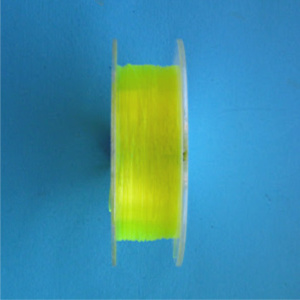 Yamatoyo tenkara line - fluorescent chartreuse
Yamatoyo tenkara line - fluorescent chartreuse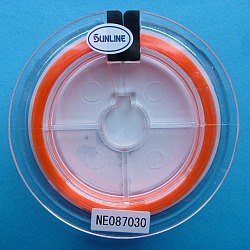 Sunline tenkara line
Sunline tenkara linefluorescent orange
I have caught lots and lots of fish with hi-vis fluorocarbon lines. It is critical to keep the bright line off the water's surface at all times, though. Don't even let the line touch at the end of your cast and then pick it up immediately. Don't let it touch the water at all! If you have to shorten your line and lengthen your tippet a bit, do so.
Still, since the upstream worm - also called the clear-water worm - is generally fished in low, clear water, you will need all the stealth you can muster. Using a longer tippet has advantages beyond just keeping the hi-vis line off the surface, it also keeps it further away from the fish.
Upstream Worm Lines and Line Sag
Upstream Worm Hooks and Hooking
“The bitterness of poor quality remains long after the sweetness of low price is forgotten” - Benjamin Franklin
"Be sure in casting, that your fly fall first into the water, for if the line fall first, it scares or frightens the fish..." -
Col. Robert Venables 1662
As age slows my pace, I will become more like the heron.
We've all had situations where seriously chewed up flies kept catching fish after fish after fish. It is no sin to tie flies that come off the vise looking seriously chewed up.
Warning:
The hooks are sharp.
The coffee's hot.
The fish are slippery when wet.
Beware of the Dogma
Seriously, all the hooks sold on TenkaraBum.com, whether packaged as loose hooks or incorporated into flies, are sharp - or as Daiichi says on their hook packages, Dangerously Sharp. Some have barbs, which make removal from skin, eyes or clothing difficult. Wear eye protection. Wear a broad-brimmed hat. If you fish with or around children, bend down all hook barbs and make sure the children wear eye protection and broad-brimmed hats. Be aware of your back cast so no one gets hooked.
Also, all the rods sold on TenkaraBum.com will conduct electricity. Do not, under any circumstances, fish during a thunder storm. Consider any fishing rod to be a lightning rod! Fishing rods can and do get hit by lightning!
What's in stock?
Kurenai II AR 30F
Kurenai II AR 33F
Kurenai II AR 39F
TenkaraBum 33
TenkaraBum 36
TenkaraBum 40
Nissin Oni Tenkara Line
Coming Soon
January
Furaibo TF39
Furaibo TF39TA
Latest Pages
If you enjoy spin fishing or baitcasting please visit my sister site Finesse-Fishing.com.


